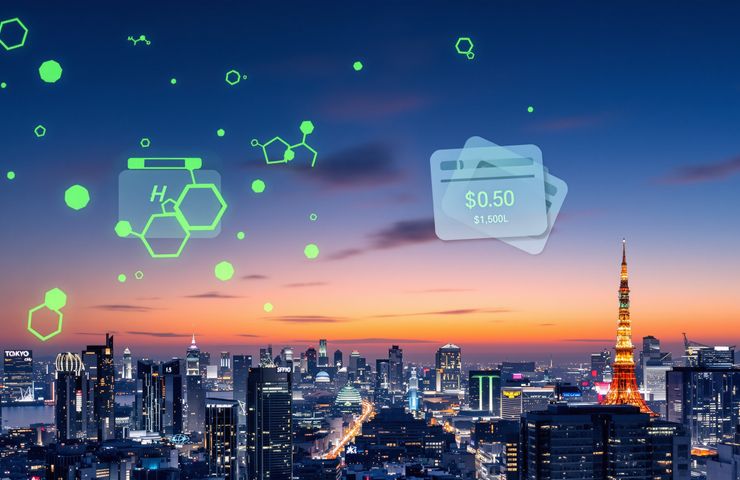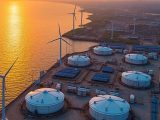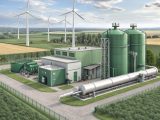
Green Hydrogen Auctions Propel Tokyo’s Hydrogen Market Forward
October 16, 2025Picture this: powering a metropolis like Tokyo with a fuel that only exhales water vapor. On October 6, 2025, the Tokyo Metropolitan Government launched its second round of Green Hydrogen Auctions—a clever Double-Sided Auction Mechanism modeled on Germany’s H2Global Foundation. Suppliers bid as high as $23 per kilogram, buyers capped at $16.76/kg, and TMG covered the gap through subsidies. It’s a bold experiment, aiming to take electrolytic tech from prototypes to paychecks, underscoring Tokyo’s commitment to its Net-Zero Hydrogen Strategy.
With nearly 14 million residents crammed into high-rises, factories, and winding streets, Tokyo is Japan’s nerve center. But with less than 10% of its energy produced at home, Tokyo imports over 90% of its fuel. Enter hydrogen: a game-changer for diversifying energy, slashing carbon emissions, and beefing up energy security. By tapping into its industrial muscle and clean-power plans, Tokyo’s setting the stage for the Tokyo Hydrogen Market to flourish—from transport and power plants to heavy-duty industrial uses that are notoriously hard to decarbonize.
A quick look at hydrogen’s journey in Japan
Japan’s been tinkering with hydrogen for years. Back in 2017, the government rolled out its National Hydrogen Strategy, mapping out a path to bring hydrogen and fuel cells into the mainstream. The world got a teaser during the 2020 Tokyo Olympics: hydrogen-powered cars, torch relays fueled by H2, even demo plants. But those early efforts were mostly window dressing—electrolyzer prices stayed sky-high and demand was niche, pushing production costs to $23–$29.75/kg. Recognizing they needed more than demos, Tokyo’s policymakers pivoted to a market-creation approach, giving rise to these Green Hydrogen Auctions.
Bridging the cost gap: the Double-Sided Auction Mechanism
At the heart of it lies the Double-Sided Auction Mechanism, where suppliers and buyers submit blind bids on a centralized platform. Producers quote the lowest price they can make electrolytic hydrogen for, while buyers state their ceiling price for a guaranteed supply. Then TMG plays matchmaker and foots the bill for any price mismatch.
- Makes deals happen even when supply and demand prices don’t overlap initially.
- Reveals real costs, arming investors with solid data on electrolyzers and renewables.
- Shares the risk for early adopters, giving everyone the confidence to take the plunge.
In the inaugural auction, the clearing price hit $23/kg—well above the national goal of $4–$6/kg. The second round nudged buyer bids up to $16.76/kg, hinting at growing appetite in the Tokyo Hydrogen Market. “These auctions are a game-changer,” says a TMG spokesperson. “We’re finally seeing genuine price signals and real commitments on both sides.”
Who’s driving the auction?
- Tokyo Metropolitan Government (TMG): Sponsors the auctions, manages subsidies, and weaves the program into its broader Net-Zero Hydrogen Strategy.
- H2Global Foundation: The German outfit that designed the blueprint, providing technical know-how, bidder outreach, and best practices from Europe’s own hydrogen plays.
Together, they combine policy clout and market savvy to build a playbook for hydrogen markets worldwide.
Why it matters
Even though volumes are still modest, the early wins are crystal clear:
- Market transparency: Auction results are public, so everyone sees the real cost and demand figures.
- Innovation boost: Producers are racing to improve electrolyzer efficiency and slash renewable-power prices.
- Demand creation: With a guaranteed floor price, industrial and utility players feel safe committing to green hydrogen.
- Economic ripple effects: New infrastructure means fresh jobs in manufacturing, logistics, and R&D.
- Policy alignment: It dovetails neatly with Japan’s hydrogen roadmap and global climate commitments.
Challenges ahead
Of course, no trailblazing effort is without snags. Stakeholders are watching:
- Fiscal strain: Subsidies of $6–$10 per kg add up fast—TMG must juggle ambition with budget limits.
- Limited scale: Current auction volumes are proof-of-concept, not full-scale rollout.
- Infrastructure gaps: More pipelines, storage, and refueling stations are required before hydrogen goes mainstream.
- Market swings: Volatile renewable energy prices and supply-chain hiccups can drive up production costs.
What’s next?
These auctions are more than a pilot; they’re a living laboratory for the Tokyo Hydrogen Market. Potential next steps include:
- Scaling up auction volumes and tightening price bands as tech costs drop.
- Expanding into hard-to-abate sectors like steel and cement, using hydrogen as a zero-carbon feedstock.
- Establishing international trading hubs out of Tokyo’s port facilities.
- Crafting cross-border regulations and certification for hydrogen transport.
“Our dream is to make green hydrogen as affordable and easy to get as natural gas,” notes a government official. “We’re laying the groundwork today.”
The Tokyo experiment might be in its early innings, but it’s already sending shockwaves through energy markets and policy circles worldwide. As these Green Hydrogen Auctions roll on and data piles up, we’ll get a sharper picture of how to transform hydrogen’s promise into commercial reality—fueling cities and industries without the carbon hangover.



 With over 15 years of reporting hydrogen news, we are your premier source for the latest updates and insights in hydrogen and renewable energy.
With over 15 years of reporting hydrogen news, we are your premier source for the latest updates and insights in hydrogen and renewable energy.